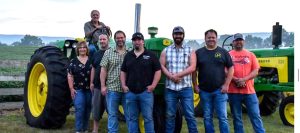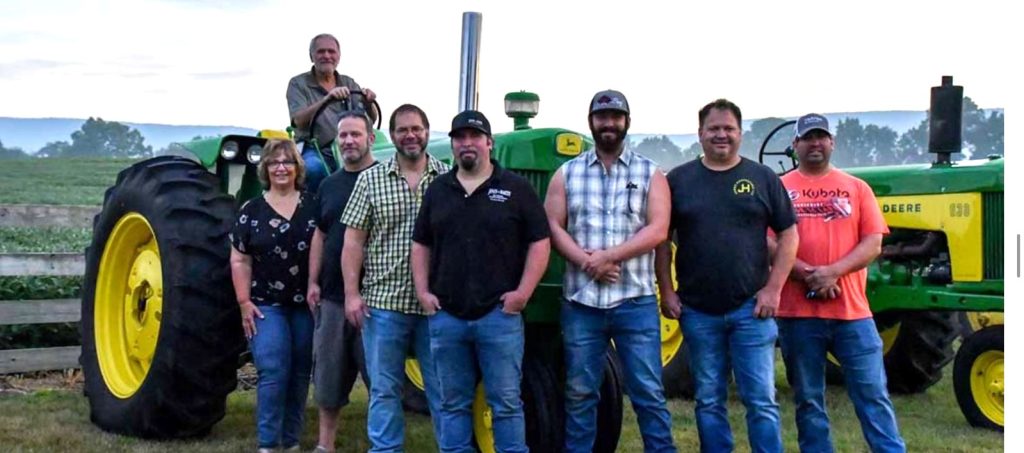
Cory Mellott and Kerry & James St. Onge Were Interviewed in the “Cow-Side Conversations” Podcast
In the Center for Dairy Excellence’s latest episode of the “Cow-Side Conversations” podcast, Cory Mellott and Kerry and James St. Onge – all middle managers at Molly Pitcher Milk LLC – share how they are helping to bring new life into an existing dairy operation in Cumberland and Franklin Counties, Pennsylvania. Their owners, the Jones family, purchased the dairy farm in 2022, taking an operation without a next generation in line and bringing together a highly motivated team. With the Molly Pitcher team now milking approximately 760 cows, Cory, Kerry and James share some of their innovative approaches to managing cows between two facilities, building trust with existing employees, completing a heat audit for cow comfort, analyzing benchmarking data, and managing a digester and Air B&B rental house that are on the property.
Gerald and Margie Jones and their six sons own Jones Harvesting, which farms approximately 15,000 acres over three states. The six brothers are partners with various enterprises, including a beef feedlot, butcher shop and other businesses. In 2022, the Jones purchased a dairy operation in Shippensburg, PA, now known as Molly Pitcher Milk LLC, as well as Maystone Dairy. They hired Cory, Kerry and James as middle managers who could cultivate a team of existing employees and bring the dairy to the next level. Cory helps with operations, including payroll, benchmarking, taking care of the farm’s digester and other mechanical tasks. Kerry oversees their herd and their employees, and volunteers to give regular farm tours. James manages the majority of the breeding on the dairy operation.

“The farm is pretty close to the I-81 corridor, so it would have probably ended up becoming warehouses at some point in time. It fit into our operation because the Jones family has a large feeding herd of beef animals that we take to our butcher shop and provide back to the community,” Cory shares in the podcast. “If we have dairy cows that we don’t want a replacement out of, that’s a good way to get our youngstock for beef through the dairy animals using sexed semen. That strategy has worked out.”
Both Molly Pitcher Milk and Maystone Dairy are purchased feed dairies, which complements some of the Jones’ other enterprises. Since they have so many employees across all their businesses, individuals who specialize in certain areas can help solve problems on the dairy operation as well.
“Jones Harvesting does the crop raising, and Molly Pitcher and Maystone Dairy purchase feed from Jones. Instead of having to do everything through cash grain, it goes through the dairy as silage or high-moisture corn,” Cory explains. “We also get manure back from the dairies on the harvesting side, so it complements those aspects of the businesses.”
According to Cory, one benefit to having two separate dairy operations is for record keeping and benchmarking.
“We both ship to Land O’Lakes. We can see different pay scales on things like direct load dairy. We also use the same nutritionist for both dairies. It makes it easier for me on the benchmarking side to monitor labor per animal,” Cory says. “Since we have two dairies, if you think something is funny on one, you can look at the other. It helps you pinpoint certain areas. I like the idea of still having separate numbers.”
Cory also works with Horizon Farm Credit to compare themselves to other dairies in Pennsylvania through benchmarking data. They can visualize the areas where they might be in the top five percent and where there might be too many input costs that are hurting their finances.
“As a purchased feed dairy, some of the feed wasn’t hauled in yet [when we were benchmarking]. Depending on when the bills hit, it could look really good one month and really bad another. So, we averaged those out,” he explains. “Based on how much storage we have here, we can spread it out and plan how much feed we can pre-buy. Those benchmarking meetings are very valuable.”
Along with benchmarking, employee management has been key to driving their operation forward. During the podcast, Kerry shares how they built trust with an existing team of employees who primarily speak Spanish. Kerry has over 20 years of experience working with Spanish speakers. Their employee management philosophy is to help their team understand the “why” behind what they do.
“Our employees were used to a previous owner. New faces and leadership were coming in, so there were some growing pains in the beginning. We had to put our time in to earn their trust and respect,” Kerry shares in the podcast. “A huge part of our management style is communication. They are our teammates, so we keep them informed on what we’re seeing and changes we want to make. They don’t need a dictator. We love working together, and we want them to point things out to us. Whether it’s our somatic cell count or breeding program, we want them to know our end goal and where we’re at.”
Some of their goals for the dairy business are closely connected to employee management:
- Rely on record-keeping to improve communication between shifts. “We really love record-keeping and charting everything. With our somatic cell count, James will plot it on a graph. We show them where we were, where we want to be, and if we’re on the right track. Recently, we implemented a spreadsheet to help us document [this data]. We have different crews going in for different milkings, so it’s better communication for our employees. When the next shift comes in, they have the paperwork to see what the morning crew observed,” Kerry says.
- Get the team involved in the solution. During a heat spell, Kerry says their team noticed more lame cows than usual. “They saw firsthand that our hospital pen was getting full. We decided to try running an extra footbath a day until we saw the herd was back to normal. It’s never just an order from us saying, ‘Do an extra foot bath.’ We want them to understand why we’re doing it and what we’re looking for. I love it when our team comes up and asks if things are getting better. It tells me they care, they’re interested, and they’re on the team with us,” she adds.
- Write out explanations and translate them. “With the milking staff, we’ve explained why it’s important to have cows milked a certain way. We try to keep them aware of what we’re doing and why we’re doing it. Anything that really needs an explanation, we’ll type it up and translate it in English and Spanish so they get a good idea of what we’re aiming for,” James explains.
- Encourage employees to contribute to decisions. “We normally bed the barns twice a week. Last week, I had to skip one of the groups because I had to haul cows. I actually had an employee come up to me and tell me I needed to get bedding into one of the groups. They are comfortable telling us those things. That’s what we want. We want to see what they’re seeing. Everyone holds each other accountable,” James adds.
Throughout the podcast, the team describes other unique aspects to their operation. They recently completed a heat audit in all their barns. An infrared camera helped them visualize the heat levels in the dry cow barns, holding areas, and other key areas.
“After watching the infrared camera, it showed the big fans do not do a great job unless the cow is directly underneath the fan. It also showed the holding areas were a big pinch point for us. As you start to get the cows together, there’s all that temperature,” Corey shares.
“One of the things I found interesting from the heat audit was a dirty fan. It ran about 20 miles per hour less if that fan was dirty instead of clean. That’s a priority here because it makes such a difference on cows. That’s something we took away from the heat audit. When you see it on paper in black and white, it’s worth taking the time to clean fans,” Kerry adds.
The Molly Pitcher team also describes their decision to use free choice liquid whey to offset the amount of protein the cows need. They discuss the learning curves they experienced with a digester that was there when they purchased the farm. The digester allows them to generate electricity and accept food waste from their community. In addition, they have a rental house on the property, and Kerry gives personalized, optional farm tours to the guests who stay at the house. She says 99 percent of guests, including people from as far away as South Korea, have taken the tour.
“There are so many people who have a misconception of large farms or farmers in general. We want them to see how passionate we are about what we do, the animals, how well they’re treated, and inspire people. We need future farmers in this industry,” she says.
With a milking parlor that can hold 1,200 cows, the Molly Pitcher Milk team embraces a growth mentality that their owners have instilled in the business.
“A lot of other people would look at a situation and say, ‘That’s not worth it. We don’t want to do it.’ For the Jones family [who purchased this dairy], they’ll look at the same situation and their mentality is, ‘We can figure something out.’ They have a lot of good people who work really hard,” Cory shares.
To listen to the full podcast interview with the Molly Pitcher Milk team, visit www.centerfordairyexcellence.org/podcast. The podcast is also available on Spotify, Apple Podcasts, and Amazon Music. With a new episode released each month, their interview is the 12th episode in the third season. The podcast was designed to share real-time farmer insight, tricks of the trade, and inspiring stories from dairies across Pennsylvania.

